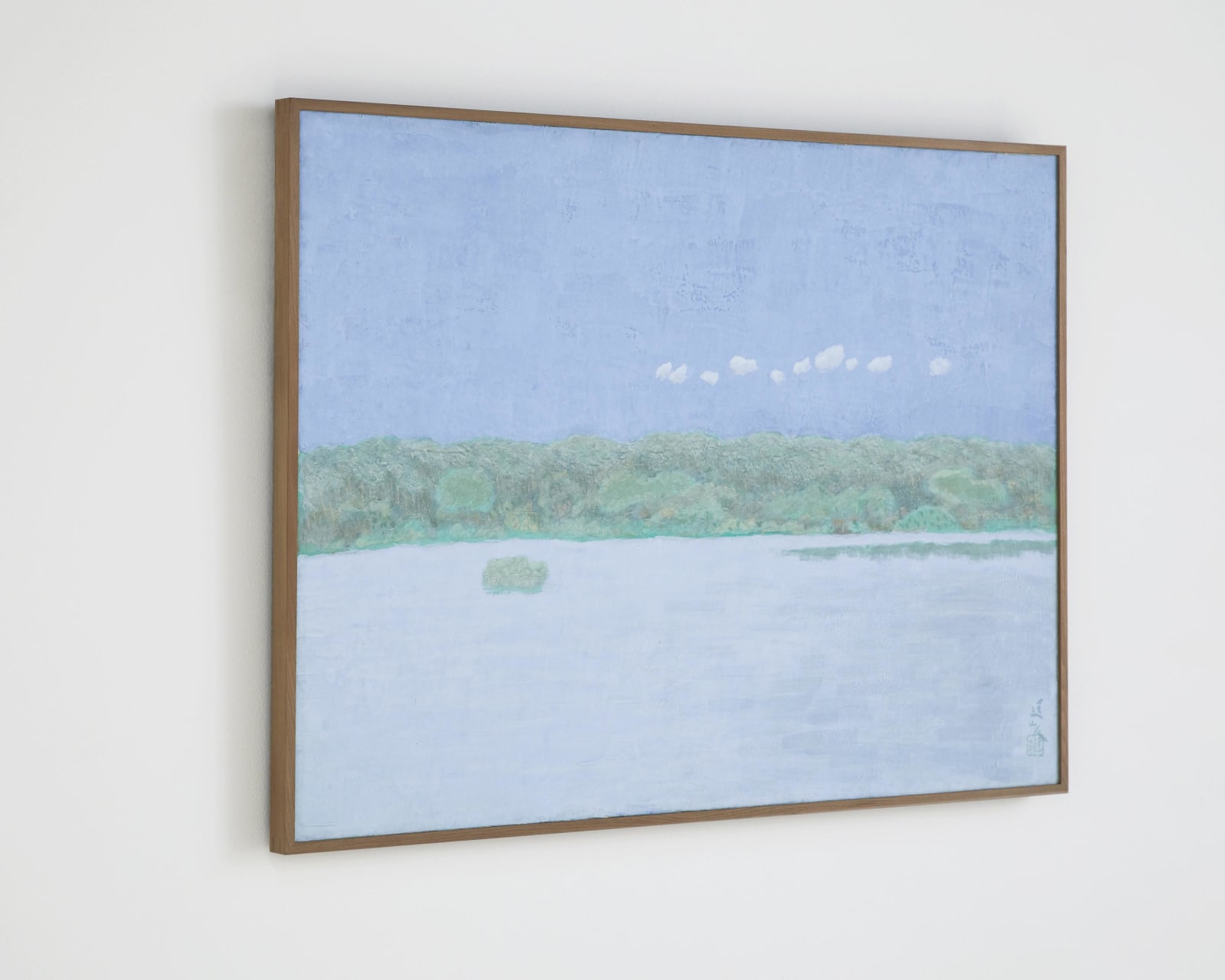Ikeda Yōson (1895–1988)
Reed Warbler
Color on paper, framed (30P)
With a label signed by the artist
Seal: Yosanjin
65 x 90 cm
67 x 92 cm (overall)
Further images
Gyogyoshi is a general name for any of a variety of types of warbler of the genus Acrocephalus, family Acrocephalidae, more commonly known by the alternate name yoshikiri, or “reed warbler.” The name is meant to suggest the sound of the bird’s cry, which is raucous enough to prevent one from sleeping at night, as was famously portrayed by Matsuo Basho in his haiku poem “good for nothing / I just wish to sleep / you noisy bird” found in his Saga nikki diary, a compilation of poems composed while he was staying at the Rakushisha hermitage in Saga, Kyoto. At first glance, the pale color scheme and play of light typical of Ikeda Yoson’s painting style seem to reflect a world view similar to that seen in his Santoka series based on the haiku poetry of a poet by that name that is representative of his later years, but surely there is no question that it actually takes its subject from the poem “rowdy the warbler / as the great river, silent / flows by” by Kobayashi Issa, published in his Bunsei kucho (Haikai poetry notebook for the Bunsei era). The string of clouds drifting low in the blue sky also suggests a tranquil, hazy spring day, replicating the feel of the poem with its contrast between the wide river that flows calmly and quietly by and the clamorous cry of the reed warbler that reverberates as it cuts through the surrounding stillness, resulting in a work that can be enjoyed both with the sense of sight as well as the sense of sound.
As is notable in the Santoka series, Yoson’s paintings of large subjects are known to feature completely unexpected small details, with three or four elements resonating against each other to produce a distinctive poetic sentiment in his work. However, this painting differs considerably from that style of composition, rendering the scene with frank directness. This simplicity of the form of expression seen here could also be considered a creative integration of the spirit of haiku poetry.
Ikeda Yoson (nihonga painter; 1895−1988)
Okayama-born nihonga painter. His real name is Shoichi. Graduated from the Kyoto City School of Arts. Learned yoga at Matsubara Sangoro’s private school, Tensai-gajuku. Later became a disciple of Chikujo-kai founded by Takeuchi Seiho. Established a style of vivid colored landscapes using bird’s eye view under the influence of Tomita Keisen. Co-founded Suimei-kai and Sosei-sha with Uemura Shoko and Hamada Kan respectively. Founded his private school, Seito-sha, devoting to the cultivation of young painters. Also appointed a jury in Shin-bunten and Nitten. Consultant to Nitten. Member of the Japan Art Academy. Designated as a Person of Cultural Merit, and received the Order of Culture.
As is notable in the Santoka series, Yoson’s paintings of large subjects are known to feature completely unexpected small details, with three or four elements resonating against each other to produce a distinctive poetic sentiment in his work. However, this painting differs considerably from that style of composition, rendering the scene with frank directness. This simplicity of the form of expression seen here could also be considered a creative integration of the spirit of haiku poetry.
Ikeda Yoson (nihonga painter; 1895−1988)
Okayama-born nihonga painter. His real name is Shoichi. Graduated from the Kyoto City School of Arts. Learned yoga at Matsubara Sangoro’s private school, Tensai-gajuku. Later became a disciple of Chikujo-kai founded by Takeuchi Seiho. Established a style of vivid colored landscapes using bird’s eye view under the influence of Tomita Keisen. Co-founded Suimei-kai and Sosei-sha with Uemura Shoko and Hamada Kan respectively. Founded his private school, Seito-sha, devoting to the cultivation of young painters. Also appointed a jury in Shin-bunten and Nitten. Consultant to Nitten. Member of the Japan Art Academy. Designated as a Person of Cultural Merit, and received the Order of Culture.







